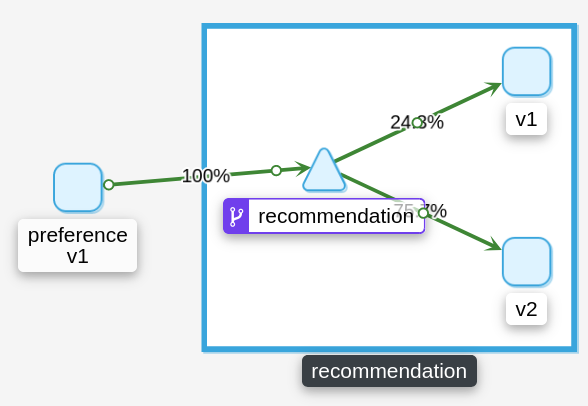Blue Green deployments in OpenShift Service Mesh
Whats a Blue Green deployment and how to configure it our microservices within the Service Mesh? How change the balancing of our requests in a easy and quick way?
Let’s Mesh in!!
This is the fifth blog post of the Service Mesh in OpenShift series. Check the earlier posts in:
- I - Service Mesh Installation
- II - Microservices deployment in Service Mesh
- III - Including microservices in Service Mesh
- IV - Ingress Routing & Traffic Management in Service Mesh
Overview
In this blog post, we will deep dive in the traffic management, specifically into the Blue Green deployments and how to implemented into our Mesh
NOTE: this blog post is supported by the istio-files repository located in my personal Github
0. Prerequisites
- OpenShift 4.x cluster (tested in a 4.3+ cluster)
- OpenShift Service Mesh Operators installed (v1.1.1 in these blog posts)
- Service Mesh Control Plane deployed
- Four microservices deployed (follow the second blog post)
- Microservices added within Service Mesh (follow the third blog post)
- Including microservices in Service Mesh (follow the fourth blog post)
Export this environment variables to identify your cluster and namespace:
$ export APP_SUBDOMAIN=$(oc get route -n istio-system | grep -i kiali | awk '{ print $2 }' | cut -f 2- -d '.')
$ echo $APP_SUBDOMAIN
apps.ocp4.rglab.com
export OCP_NS="istio-tutorial"
1 Blue/Green Deployment
A Blue/Green deployment will allow you to define two (or more) versions of the same application to receive traffic with zero downtime. This approach, for instance, will let you release a new version and gradually increment the amount of traffic this version receives.
1.1 Deploy recommendation v2
To deploy a new version of the same application, in this case recommendation service, we are going to use exactly the same command oc new-app but we must take into account the following:
-
The label app must be the same between different versions of the same app. Remember that we modified the k8s service to use a wider selector based on this label.
-
The label version will identify the subset of the new pods created for this DeploymentConfig.
-
Both app and version labels are used by Istio and Kiali internally
Deploy recommendation v2:
oc new-app -l app=recommendation,version=v2 --name=recommendation-v2 --docker-image=quay.io/rcarrata/recommendation:vertx -e JAVA_OPTIONS='-Xms512m -Xmx512m -Djava.net.preferIPv4Stack=true' -e VERSION=v2 -n $OCP_NS
oc delete svc/recommendation-v2 -n $OCP_NS
service "recommendation-v2" deleted
$ oc get pods -n $OCP_NS | grep recommendation-v2
recommendation-v2-1-deploy 0/1 Completed 0 4m5s
recommendation-v2-1-n5t9f 1/1 Running 0 4m1s
Apply the istio sidecar injector:
oc patch dc/recommendation-v2 -p '{"spec":{"
template":{"metadata":{"annotations":{"sidecar.istio.io/inject":"true"}}}}}' -n $OCP_NS
deploymentconfig.apps.openshift.io/recommendation-v2 patched
$ oc get pod | grep recommendation-v2
recommendation-v2-1-deploy 0/1 Completed 0 7m
recommendation-v2-2-deploy 0/1 Completed 0 89s
recommendation-v2-2-nqq9f 2/2 Running 0 85s
Once your pod has 2/2 containers and it is Running, execute some test either using customer or partner services.
$ oc get routes -n istio-system | egrep "customer|partner"
customer customer-istio-tutorial-istio-system.apps.ocp4.rglab.com istio-ingressgateway http2 None
partner partner-istio-tutorial-istio-system.apps.ocp4.rglab.com istio-ingressgateway http2 None
$ curl customer-istio-tutorial-istio-system.apps.ocp4.rglab.com
...
customer v1 => preference => recommendation v1 from 'recommendation-2-kjpsc': 528
customer v1 => preference => recommendation v2 from '2-nqq9f': 1
customer v1 => preference => recommendation v1 from 'recommendation-2-kjpsc': 529
customer v1 => preference => recommendation v2 from '2-nqq9f': 2
customer v1 => preference => recommendation v1 from 'recommendation-2-kjpsc': 530
If you check the traffic you can notice that its load balanced with Round Robin algorithm (50/50% to v1 and v2). This is because is not configured any VirtualService or DestinationRule yet.
1.2 Applying routing weights in our mesh
Apply the VirtualService with the 25% of the traffic to the recommendation v1 and the 75% to the v2:
$ cat istio-files/recommendation-v1_v2_mtls.yml
apiVersion: networking.istio.io/v1alpha3
kind: VirtualService
metadata:
name: recommendation
labels:
group: recommendation
spec:
hosts:
- recommendation
http:
- route:
- destination:
host: recommendation
subset: v1
weight: 25
- destination:
host: recommendation
subset: v2
weight: 75
---
Then you need the destination rule to define the subsets that are going to route between:
apiVersion: networking.istio.io/v1alpha3
kind: DestinationRule
metadata:
name: recommendation
labels:
group: recommendation
spec:
host: recommendation
trafficPolicy:
tls:
mode: ISTIO_MUTUAL
subsets:
- labels:
version: v1
name: v1
- labels:
version: v2
name: v2
Apply the recommendations:
oc apply -f istio-files/recommendation-v1_v2_25_75.mtls.yml
Let’s generate some load. For doing this we can do it with curls, but with this simple program you can generate this load:
$ cat istio-files/test.sh
#!/bin/bash
url=$1
i=0
while :
do
echo Request Number $i:
((i++))
curl $url
echo ""
#sleep 1
done
And after that we can check in Kiali that the traffic balanced with 25/75 (approx) to the v1 and v2:
So, now you can play with your weight and configure different behaviours to control the routing between your different versions of your same repository deployed.
Check out the part six of this blog series in Canary deployments in Service Mesh
NOTE: Opinions expressed in this blog are my own and do not necessarily reflect that of the company I work for.
Happy Service Meshing!


